#thecodontosaurus
Explore tagged Tumblr posts
Text

"What is to come"
(image id is both in the alt text and below the read more- I put it under one because it's incredibly long)
And so there we have it, the 200+ followers artpiece that I have been working on for several days, if I had to guess I'd say it took 25 or so hours over eleven days. Honestly it's so surreal to me that I'm here with over 200 followers (260 as of typing this- yes, I procrastinated on this), especially when I only hit 100 followers in February. It's genuinely really nice to know that people are actually interested in my art (before anyone brings up spam bots- I know there are a few of them amongst my followers but I've checked most of them and I am 100% confident that over 200 of them are real). I don't really have much else to say really- I'm just grateful to have the support. Thanks y'all :).
[Image id: a large, lineless digital drawing of several dinosaurs. It is nighttime. At the bottom of the piece, a lone Eoraptor lunensis is walking across the floodplains- both the ground and the Eoraptor are just silhouettes, the early dinosaur has been given protofeathers. The full moon is shining, it's size is exaggerated for artistic affect. Behind the moon, the heads of sixteen different dinosaurs can be seen (listed left to right, bottom to top) Row 1- Thecodontosaurus antiquus (small sauropodomorph with light brown protofeathers, near-white undersides, straight stripes that are moderately darker than the base colour and vibrant green eyes), Coelophysis bauri (small early theropod with a long and narrow skull, its protofeathers are golden and black. A soft orange stripe runs across the back of its head, it has warm brown eyes. Row 2- Plateosaurus trossingensis (long-necked sauropodomorph, it has reddish-brown scales, light undersides, triangular stripes running down it's spine that get bigger the further down they get and pale yellow eyes), Heterodontosaurus tuckii (small ornithopod with a hooked grey beak. It has spiky green feathers, a lighter chest and a darker stripe running along its head and back, there are three small spots on its face, two behind the eye and one infront of it, it's eyes are bright yellow). Row 3- Megalosaurus bucklandii (medium-sized theropod with warm brown feathers, lighter undersides, dark spots and bright yellow eyes, there are several scars on its face), Brachiosaurus altithorax (greenish-grey true sauropod with lighter undersides, a dark pink patch on its throat, dark desaturated brown eyes and a few small scars on its neck), Archaeopteryx (early toothed bird with a black head, white neck and bright yellow eyes). Row 4- Hylaeosaurus armatus (pale brown ankylosaur with lighter undersides and vibrant green eyes), Velociraptor mongoliensis (dromaeosaur with light brown feathers, a lighter chest, a black stripe near its eye and light green eyes), Sinosauropteryx prima (small compsognathid theropod with ginger protofeathers, an off white mask and undersides and pale yellow eyes), Iguanodon bernissartensis (large greenish-grey ornithopod with a slightly darker back, pale undersides, a grey beak, and yellow eyes). Row 5- Matuku otagoense (heron with medium grey feathers and a small crest. A red stripe runs from just behind its nostrils to about a third of the way down its neck. Its undersides are white, its beak is grey and its eyes are brown), Triceratops prorsus (three-horned ceratopsian with grey-brown scales, lighter undersides, two triangular stripes between it's brow and nasal horns, reddish-orange diamond-like stripes on its frill, a hooked grey beak and golden eyes. Its brow horns curve forward at the base. Row 6- North Island brown kiwi (plump brown bird with a long pale beak, whiskers and black eyes, its nostrils are at the tip of its bill, and unlike the other dinosaurs in the sky part of its body below the neck is visible), male house sparrow (small redish-brown and grey bird with a black bib below it's bill), it has brown eyes and a dark grey bill. Row 7- rock dove (grey bird with iridescent green feathers scattered across its neck, a dark grey beak, and warm brown eyes). end id]
#art#my art#digital art#paleoart#dinosaurs#birds#eoraptor#thecodontosaurus#coelophysis#plateosaurus#megalosaurus#brachiosaurus#archaeopteryx#hylaeosaurus#velociraptor#sinosauropteryx#iguanodon#matuku#triceratops#north island brown kiwi#house sparrow#rock dove
3K notes
·
View notes
Text




My 25 years of palaeoart chronology...
In 2013 I built a life-size model of Thecodontosaurus for the Bristol Dinosaur Project. Here is how it was built, part 8 of 9.
#Art#Painting#PaleoArt#PalaeoArt#SciArt#SciComm#DigitalArt#Illustration#Dinosaurs#Birds#Reptiles#Palaeontology#Paleontology#Thecodontosaurus#FossilFriday
302 notes
·
View notes
Text
A group of visionaries have figured out how to bring nonavian dinosaurs to the present, and have determined the 10 species that make the best pets and domesticated them, with an oversimplified guide to what modern pet/livestock/husbandry animals they resemble most. you have done the work, you're completely prepared, and today, you're bringing your new friend home.
you will be able to take care of the pet and they will become your best friend for the rest of your lives. there are no downsides to any of these pets apart from what is in the brief description.
the pets, with image descriptions indicating which is which and artist credit, with artist links attached:

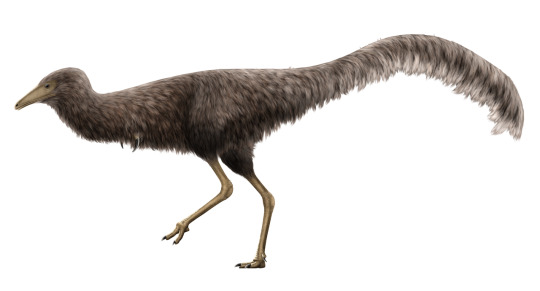

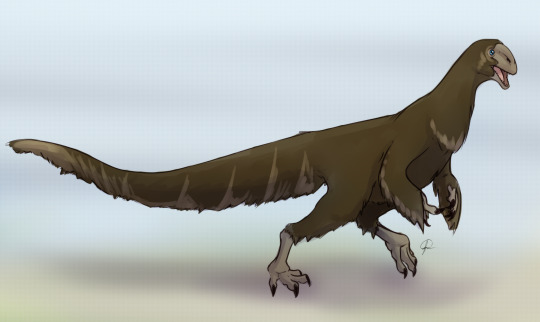

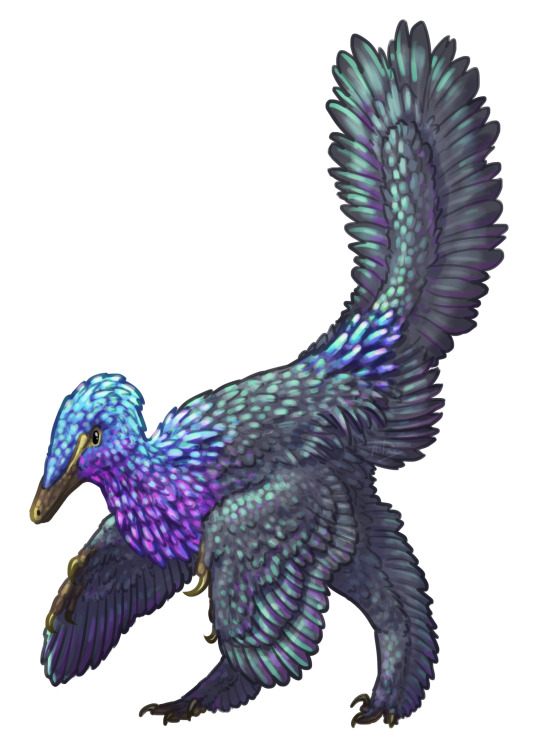

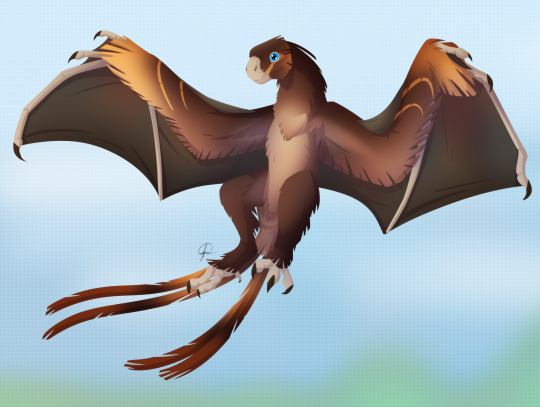
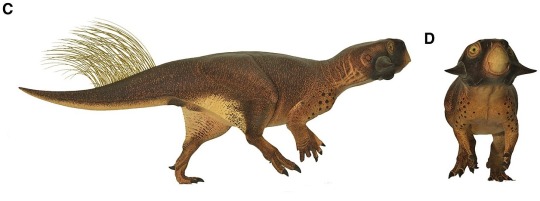

#palaeoblr#dinosaurs#pets#polls#prehistoric life#velociraptor#mononykus#tongtianlong#thecodontosaurus#kulindadromeus#caihong#scutellosaurus#yi qi#yi#psittacosaurus#heterodontosaurus
2K notes
·
View notes
Text
Two more legs, but then it's time to work on those arms/wings!
I added a cut, as anatomical ddrawings can make people feel a bit uncomfortable. I'm not sure how to feel about it myself yet.


These are both ostrich leg muscles. Maybe not too dissimilar from a Gallimus?



A duck's wing, and two dinosaurs based on other people's images: one on a paper on Thecodontosaurus' muscles, one based on a Microraptor drawing by Rushelle Kucala (with added feather impressions based on a fossil.)

A vulture's wing

A Baryonyx arm and claws. I used purple as it would seem very neutral against the ochre. But it did so too well and now it just looks like grey 😓
#Tw: anatomy#art#nature#dinosaurs#paleoart#birds#watercolour pencils#watercolours#ostrich#Duck#microraptor#Thecodontosaurus#Vulture#baryonyx#Anatomy#Legs#Wings#ornithology
21 notes
·
View notes
Text

Theoretical feathers on the Bristol Dinosaur
#thecodontosaurus#bristol dinosaur#dinovember#dinovember2024#dinosaur art#dinosaur#adgreenlees#unscrupulousartist#canadian artist#art challenge#daily art
4 notes
·
View notes
Text

Running Thecodontosaurus antiquus, a basal sauropodomorph from the Late Triassic (Rhaetian) of Southern England. This reptile was described in 1836 from finds from a quarry in present-day Bristol. Then it was classified as squamate, and the name ("lizard with teeth in sockets" in translation) emphasized the differences in the fastening of teeth). It was only in 1870 that Thomas Huxley attributed Thecodontosaurus to dinosaurs (now it is obvious that all dinosaurs had thecodont teeth attachment). Later, many bones were found in the "fissure fillings", some of which were destroyed during the bombing of Bristol. Today, about 245 fragmentary fossils are known, from which it is possible to make up almost an entire skeleton. In 1891, the supposedly Australian material of Thecodontosaurus was separated into the genus Agrosaurus, but it turned out that it was incorrectly labeled. One juvenile specimen was describes as the genus Pantydraco in 2007. Thecodontosaurus was a small long-tailed dinosaur, the largest specimens were 2.5 m in length (and the average length was only 1.2 m). Michael Benton noted in 2000 that there was a robust morph among Thecodontosaurus. This may indicate sexual dimorphism.
Here I tried to convey the scaly integument with vertical hatching. Let's see how this method will manifest itself in future works. :) The filaments are speculative.
Black ballpoint pen and black colored pencil, 2023.
#thecodontosaurus antiquus#thecodontosaurus#pantydraco#basal sauropodomorph#triassic dinosaurs#late triassic#paleoart
13 notes
·
View notes
Text

A skittish Thecodontosaurus antiquus surveying its surroundings. From my book ”De första dinosaurierna” (”The first dinosaurs”)
#dinosaur#illustration#triassic#paleoart#paleontology#paleoillustration#paleoblr#palaeoblr#art#palaeontology#mesozoic#palaeoart
545 notes
·
View notes
Text
A History of What Dinosaurs Were Known up until the Bone Wars
Dinosauria was first coined in 1842, only three genera were known: Iguanodon, Megalosaurus, and Hylaeosaurus (which was named that year. The Crystal Palace Park was opened in 1852 and showed the whole world what people though dinosaurs looked like at that time.
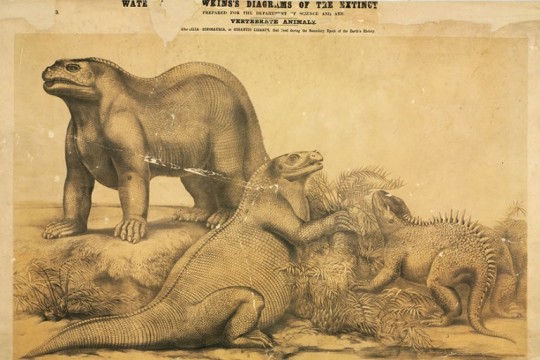
However, by then, a few dinosaurs had been added to the list and described as dinosaurs. However, most of them were teeth or otherwise remain dubious species/known from little remains.
To be fair, the initial specimens of the original three weren't that great either. Still, it was enough to get an idea of these animals.
Most histories of Dinosaur Discovery then jump to Hadrosaurus foulki which was described formally in 1858, it was published in a monogram that was meant to be released in 1860, but the civil was got in the way of that, delaying publication until 1865. This had illustrations of the animal, with a reconstruction of the skeleton being put out by 1868.
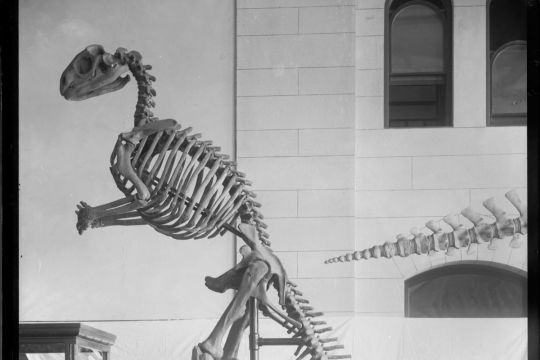
However, between 1852 and 1861, several animals were described that were realized to be dinosaurs as well. Most of them didn't change the game or were realized to be what we know them to be today.
Thecodontosaurus was the 5th overall dinosaur named and recognized as such, the 4th being a fragment they gave a name so we're not counting it. Even then, the material was not great for Thecodontosaurus, so its actual ties remained unrealized (still, they recognized it was closer to Megalosaurus than Iguanodon). Next was Cetiosaurus. Found in 1841 and thought to be a massive oceanic crocodile, it was in 1856 when it was realized to be a dinosaur, but the remains were so fragmentary as to not give away its identity as a Sauropod, shoving it in closer to Iguanodon in the Victorian's minds. Next was Scelidosaurus, like Cetiosaurus, it was described by Richard Owen in 1861. It was properly lumped in relations-wise with Hylaeosaurus, but is notable for being smaller/older than Hylaeosaurus. And it confirmed to them that those two at least were still quadrupeds.
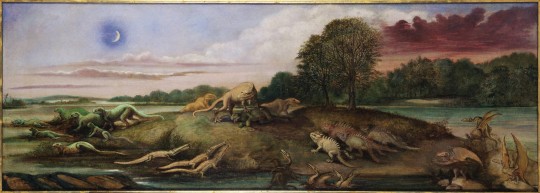
Then in 1861 came a 1-2 punch of discoveries. Compsognathus and Archaeopteryx. That was a shakeup on a lot of levels. In top of the wider knowledge of Hadrosaurus, it really shook up the understanding of Dinosaurs known at the time.

The Kangaroo posture was all in, now. Compsognathus allowing that stance to be applied to Megalosaurus.
With that established, a few more animals of note were added to the list. Of note are the Island Dwarfs Echinodon, Struthiosaurus, and Rhabdodon. Beyond them, they added Polacanthus, Dryptosaurus (known as Laelaps at the time), Hypsolophodon, and Dacentrurus (known as Omosaurus).
Of special note is Plateosaurus. First described in 1834 and described in 1837, it wasn't recognized as a dinosaur until 1867 (as near as I can tell) primarily due to the language barrier. Since it was found in Germany and most dinosaur sciences was being done in English-speaking countries.
More fragmentary material was being found by the 1870s from the west that today is considered dubious, but 1877 was the 'start' of the Bone Wars. Why?
In that year, the following animals were discovered:
Allosaurus, Apatosaurus, Camarasaurus, Nanosaurus, and Stegosaurus. Followed shortly by Diplodocus, Brontosaurus, Camptosaurus, and Coelurus. In short, the Morrison Formation had been found. These with full skeletons, showing the diversity of the Sauropods. 1876 also gave us the first 'frill' of a ceratopsian, dubbed Monoclonious. It wasn't until 11 years later that Triceratops solidified what they looked like in the eyes of scientists.
Still, I wanted to highlight that strange time between 1852 and 1877 when there were basically three 'types' of Dinosaur: Therapods, Thyreophorans, and Ornithopods.
7 notes
·
View notes
Note
top five dinosaurs?
Based purely on vibes, I have no real justification for any of these other than they look really cool or I have childhood attachment to them:
Parasaurolophus
Deinonychus
Styracosaurus
Kentrosaurus
Therizinosaurus
Also shout-out to Thecodontosaurus, the patron dinosaur of my home city!
6 notes
·
View notes
Text
Random Dino Facts #5
The title of earliest known dinosaur goes to Nyasasaurus Parringtoni, found near Lake Nyasa in Tanzania sometime in the 1930’s.

This creature lived roughly 245 million years ago, predating other dinosaurs by 10-15 million years. The significance of this species was not realised until a study in 2013 classified it as a basal dinosaur instead of an archosaur.

It was originally named Thecodontosaurus Alophos in 1932 before further examination showed it to be a completely different genus. After this it was almost completely ignored by the palaeontology community until 2013 due to the almost complete lack of fossils, with only one humerus and eleven vertebrae. Due to the lack of fossils, we do not know what the creature ate.
The study:
2 notes
·
View notes
Note
Did the very early sauropodomorphs have feathers?
I would say it is highly likely that they did! We currently have no direct evidence for or against feathers or scales on early sauropodomorphs, which means we have to rely on our understanding of other species.
We know that theropods and ornithischians posessed feathery structures at some point in their evolutionary history, and we know that pterosaurs were also fuzzy! There's actually new research that indicates pterosaur fluff does in fact share a common ancestor with dinosaur fluff, meaning all dinosaurs and pterosaurs are most likely descended from a feathered ancestor.
So what does this mean for sauropodomorphs? Well, given the earliest dinosaur was most likely feathered, early sauropodomorphs probably inherited their fluff! They were still small and vulnerable in the Triassic, and a fluffy coat like I've given this Thecodontosaurus would have helped them survive.
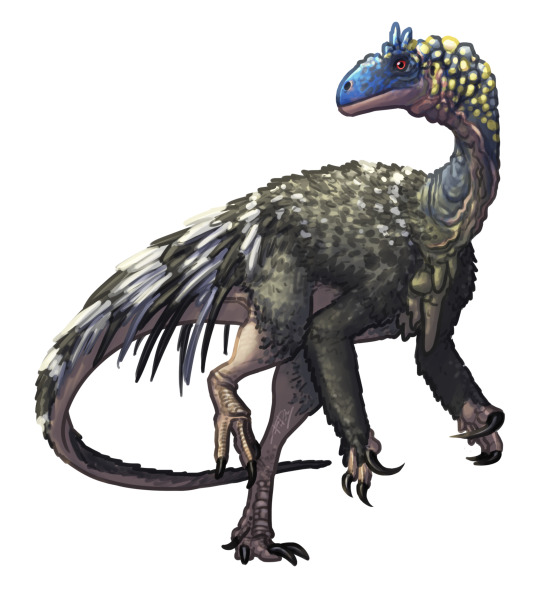
Image ID: Digital illustration of Thecodontosaurus, a small early sauropodomorph. It is a slender bipedal dinosaur, with a long tail and long, clawed arms. Its body is partially covered with a coat of feathers, except for the head and neck, which have bare, wrinkled skin like a turkey. The legs and belly are also bare, and coloured a pale brown. The feathers are dark brown, with white stripes on the quill-like feathers at the base of the tail. The head is mottled grey and yellow, with a blue face and red eye. Its body is turned towards the viewer, with one foot raised in an active pose. End ID.
However, as sauropodomorphs grew larger they probably outgrew their fluffy coats, as they would provide less protection than their large size already did and a heavy coat would risk overheating. Larger sauropodomorphs, such as the early Jurassic Lufengosaurus, may have had a few residual areas of fuzzy skin like today's giant mammals, but were probably scaly overall.

Image ID: Digital illustration of Lufengosaurus, a large bipedal sauropodomorph with a long neck and heavy torso and tail. The skin is scaly, except for a light dusting of feathers on the back and underside of the neck. Its body is light grey with darker spots on the back and light stripes on the tail. The neck fades to orange towards the small head, which is coloured a dark brown. The Lufengosaurus is in a walking pose, with both feet on the ground. End ID.
One thing we do know from skin imprints, is that later sauropods like Camarasaurus were definitely scaly. So at some point in their evolution, sauropodomorphs lost their feathers.
#dinosaurs#paleontology#paleoart#palaeoblr#sauropods#thecodontosaurus#lufengosaurus#prosauropod#triassic#jurassic#my art#prehistoric#fossils
193 notes
·
View notes
Text

North American Dinosaurs. Written by Helen Sattler. Illustrated by Anthony Rao. 1981.
91 notes
·
View notes
Text




My 25 years of palaeoart chronology...
In 2013 I built a life-size model of Thecodontosaurus for the Bristol Dinosaur Project. Here is how it was built, part 1 of 9.
#Art#Painting#PaleoArt#PalaeoArt#SciArt#SciComm#DigitalArt#Illustration#Dinosaurs#Birds#Reptiles#Palaeontology#Paleontology#Thecodontosaurus#Bristol#JurassicWorld
246 notes
·
View notes
Text
Prosauropods sure know how to party!
#remember when we all had to draw these for adad because that was a trip#dinosaurs#palaeoblr#prosauropods#plateosaurus#sauropods#massospondylus#mussaurus#anchisaurus#eoraptor
65 notes
·
View notes
Photo

Islands are natural sites for evolutionary experiments. Their isolation and limited resources put a lot of selective pressure on their native species, often resulting in spectacular and unique adaptations. Big animals become small, small animals become big, and ecological niches can end up being filled in unexpected ways.
From the dodo becoming the first well-known example of human-caused extinction, to Darwin’s Galápagos finches being influential in the development of the theory of natural selection, to famous-but-endangered living examples like the kiwi and marine iguana, island species are fascinating and often fragile examples of how diverse life can get even in restricted conditions.
In fact, this theme ended up containing so many species I wanted to feature that I can’t possibly fit them all into just a single month. So, for the first time, a theme is going to need two months -- with part 1 happening right now, and part 2 coming later this summer.
Island Weirdness #01 -- Thecodontosaurus antiquus
For much of the Mesozoic Europe was an archipelago of islands in a shallow tropical sea. During the Late Triassic, about 205-201 million years ago, some of the paleo-islands in this region existed around southern Wales and South West England, near the city of Bristol.
Thecodontosaurus was actually one of the first non-avian dinosaurs ever named by modern science, discovered in the mid 1830s -- several years before the term “dinosaur” was even created to classify the "great ancient lizards”.
It was an early member of the herbivorous sauropodomorphs, the group that would eventually include the largest ever land animals. But unlike its enormous later cousins it was short-necked and bipedal, and was particularly small compared to other contemporary “prosauropods”, measuring only about 2m long (6′6″). This would make it one of the oldest known examples of insular dwarfism.

#island weirdness 2019#science illustration#paleontology#paleoart#palaeoblr#thecodontosaurus#archosauromorpha#prosauropod#dinosaur#art#speculative fluffiness#feather ALL the dinosaurs#european archipelago#insular dwarfism#island weirdness part 1
504 notes
·
View notes
Text
The oldest known dinosaur so far discovered in Britain is Thecodontosaurus antiquus. It was discovered near Bristol . Thecondontosaurus was 2.1 metres long, about the size of a kangaroo, and ate plants. It lived on the richly vegetated islands that were around that area in Triassic times about 200 million years ago.
10 notes
·
View notes